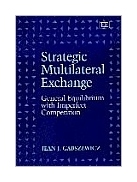|
||
podział tematyczny • wydawnictwa anglojęzyczne podział tematyczny Newsletter: • Zamów informacje o nowościach z wybranego tematu Informacje: • sposoby płatności i dostawy • kontakt • Cookies na stronie • Regulamin zakupów Napisz propresssp@gmail.com |
STRATEGIC MULTILATERAL EXCHANGEGABSZEWSKI J.wydawnictwo: EE , rok wydania 2002, wydanie Icena netto: 'To non-economists, it is
hard to understand why economists spend so much effort on the competitive model whereas
the world seems to be replete with large and powerful economic actors. In this respect,
Jean Gabszewicz is atypical: he has spent most of his research time working on imperfectly
competitive markets. However, instead of restricting himself to partial equilibrium
analyses, he has tackled from the outset the problem of imperfect competition in a system
of interrelated markets with the aim of studying how market power is spread throughout the
whole system. This is one of the most challenging and fascinating tasks that economists
face. But this is also a very hard one, and may explain why so few have tried. This book
builds on the seminal contributions of Cournot and Edgeworth and does not intend to
provide a full-fledged answer to the many questions raised by the general theory of
imperfect competition. However, by presenting in a transparent way most of the problems
that lie at the roots of imperfect competition in general equilibrium and by proposing
various elegant solutions, it paves the way to any future research in the field. No doubt
it will become a basic reference in the long run. The economics profession should thank
Jean Gabszewicz for a fresh and daring way of looking at market power.' Jacques Thisse,
Université Catholique de Louvain, Belgium and École Nationale des Ponts et Chaussées,
France Table of Contents: ntroduction Part I: Strategic Multilateral Exchange and the Core 1. Allocations in Pure Exchange Economies 2. The Asymptotic Approach 3. Markets with an Atomless Sector Part II: Strategic Multilateral Exchange and Oligopoly Equilibrium 4. The Notion of Oligopoly Equilibrium 5. The Existence Problem 6. Economic Applications 7. Oligopoly Equilibrium with a Productive Sector 8. Conclusion Bibliography Index 420 pages Księgarnia nie działa. Nie odpowiadamy na pytania i nie realizujemy zamówien. Do odwolania !. |


